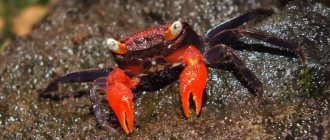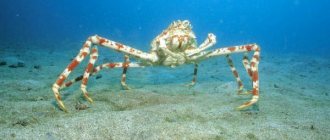Today, a new trend has emerged in aquarium farming - exotic fish are being replaced by crustaceans. They are no less beautiful, have bright colors, and are interesting to watch. The most prominent representatives of crustaceans in the home pond are aquarium crabs. Aquarium crayfish are also very interesting.
Features of keeping crabs in a home aquarium
Before you get crabs, you need to study the features of their maintenance. Most of them need more than just an aquatic environment. They must have access to land, so the best solution is an aquaterrarium.
It combines an ordinary aquarium and a terrarium-paludarium. This type of home pond is more difficult to organize and maintain. Therefore, beginners rarely decide to keep crabs in an aquarium.
Advantages and disadvantages
The main arguments in favor of purchasing:
- longer life expectancy compared to fish;
- undemanding in maintenance and care;
- unpretentiousness in feeding;
- can live as solitary hermits;
- no need for large capacity;
- are highly decorative;
- have interesting habits, are the object of observation and study;
- inexpensive.
Crabs have few disadvantages:
- you should carefully monitor the purity of the water;
- it is necessary to control the pH of the environment;
- Do not touch the animal with your hands.
A big problem in breeding and keeping crabs at home is the almost complete lack of professional information. Even sellers in pet stores cannot give professional advice on how to care for a pet to a novice lover of aquarium exotics.
Content complexity
Professional and amateur aquarists note the unpretentiousness of crustaceans. But their maintenance and care are not so simple. Crabs need to create conditions similar to natural ones. Necessary:
- change water frequently;
- wash the soil, getting rid of food residues;
- monitor the mineral composition of the water, its pH, so as not to spoil the shell;
- properly equip the aquarium to provide the crustacean with freedom of movement and the opportunity to stay in the air;
- provide shelter;
- maintain air humidity.
An aquaterrarium requires outdoor placement of all devices, as sharp claws can damage tubes and cables.
You also need a lid, because arthropods are agile “acrobats” and can get out of the container.
Difficulties may arise with the selection of plants for the pool and dry land.
Crabs love to bite branches and undermine roots.
Average life expectancy
In their natural environment, crabs can live up to 20 years and reach large sizes. In captivity, the average life expectancy is 3-4 years. In good conditions, with experienced aquarists, they can live 5-6 years.
The lifespan of crustaceans depends not only on the conditions of detention, but also on their type.
general characteristics
The crab, or otherwise short-tailed crayfish, is a representative of the phylum arthropods, the class of crustaceans and the infraorder decapods.
It has 5 pairs of limbs, the front of which is transformed into powerful claws. Sometimes during battles a sea animal may lose one of them. And in its place a new one will grow. Therefore, it is very common to see live crabs with obvious asymmetry.
The remaining 4 pairs are walking legs. With their help, the animal moves sideways. But, despite the apparent difficulty, arthropods can move quite quickly. For example, swimming crabs swim very quickly, making up to 780 strokes of their limbs per minute. And the grass crab can reach speeds of up to 1 meter per second when running.
The crab's body consists of a small head, a wide cephalothorax and stalked eyes. The abdomen is symmetrical and short, bent longitudinally under the cephalothorax. It can be round, square, and sometimes triangular in shape.
The body of the crab is covered with a chitinous cuticle. This is the exoskeleton, known as the carapace. It protects the organs of the crustacean from the effects of the external environment.
The hard cover is formed from several layers.
The inner levels are composed of the soft organic substance chitin, while the outer levels are impregnated with lime.
They also contain various pigments that give the animal a certain color.
- Lynx
- 37 facts about cheetahs
- Scolopendra
- 32 facts about tigers
- Weasel
- Whale shark
Since the hard shell limits the growth of the arthropod, the animal periodically sheds it until it grows to the required size. During the molting period, a new cover is formed under the old exoskeleton, and the old carapace bursts and the owner leaves it.
Types of crabs
There are more than 6,780 species of crabs in nature, but not all are suitable for living in an aquarium.
Mangrove lover
The red mangrove crab (Pseudosesarma moeshi) is native to Southeast Asia. It lives in the humid, warm climate of mangroves and can survive for long periods of time without water. Sometimes it wanders onto sandy beaches in search of food.
The adult is small in size: males - 4 cm, females - 3 cm. They attract with their bright coloring:
- shell - blue-red;
- legs - red-violet;
- The claws are red with lemon yellow fingers.
The optimal water temperature is +24…+25°C, air temperature is +25…+27°C. It can live in both fresh and salt water, but for optimal shell health it requires salted water.
Dwarf spider crab
This is the smallest representative of crustaceans.
The size of the carapace of adults is about 10-15 mm. The small crab (Limnopilos naiyanetri) has a nondescript appearance - a grayish color and a translucent body with pubescent legs, like those of a spider. The animal uses thick hairs on its limbs and claws to filter water and trap small particles of food. Lives in fresh, stagnant water.
The spider crab has a peaceful nature, so it can be kept in an aquarium with herbivorous, calm fish.
Due to its small size, it can live in a nano aquarium. It does not damage plants, so it is suitable for landscape and Dutch aquariums.
Freshwater Dutch crab
Another representative of freshwater crabs is the Dutch crab (Rhithropanopeus harrisi tridentate). The diameter of the shell is 2.5 cm. It is not brightly colored - it has an inconspicuous olive-brown or dark brown, almost black color.
Loves sandy soil, which is easy to burrow into, and a lot of plants where you can hide during the day. But he also needs more solid shelters: snags, stones, grottoes. Does not conflict with fish, but competes for territory with its brothers.
Good guy "red devil"
The menacing appearance of the crab (Geosesarma red devil) is the opposite of its peaceful nature.
It gets along well with calm underwater inhabitants, including shrimp and newts.
It has a small size (3-5 cm) and a characteristic color.
The limbs and sides are painted jet black, and the mask is the same shade.
The rest of the body is bright red.
An aquaterrarium with large dry land covered with mosses and marsh plants is suitable for it. Requires high (100%) air humidity.
Malawian blue crab
The Malawian crab (Potomonautes Lirrangensis) is native to Lake Malawi (Nyasa) in Africa. Valued for the rich blue color of the upper body. In artificial and reflected light it shimmers purple. The lower part is dark cherry or brown. There are red blotches or stripes on the limbs and claws.
The Malawian crab is large in size: in males the carapace diameter is 12 cm, in females - 10 cm, and the length of the limbs - 10 cm.
The character is aggressive. He constantly fights with all the inhabitants of the aquarium. He also comes into conflict with his brothers, regardless of gender.
Geosesarma dennerle (vampire crab)
This beautiful crustacean is called the vampire crab.
It lives on land and in freshwater bodies. The size of the carapace is 2.5-3 cm. It gained popularity due to its color: the body is a rich lilac color, and the eyes are orange.
Its peaceful nature and tolerance towards all inhabitants of the reservoir make it an excellent neighbor for fish and amphibians.
Geosesarma Sp. vampire yellow
Geocessarma are native to Malaysia and Indonesia and live in jungles near streams and small ponds away from the sea. They are primarily nocturnal, although they can be seen during the day if left undisturbed.
Reach a size of 5-7 cm. Legs included. They live in a terrarium in small groups. Males, like other crabs, are territorial. They can live with dendrobats.
Ideal habitat:
-Terrarium: it can be kept in swamps, always with a water area for molting and young animals. It should cover their entire body. They can be kept in an aquarium 20x20x20 for a couple of individuals or more than 60 cm for 7-8 crabs. It is possible and recommended to plant generously so that they can hide, establish territories and climb. For the same reasons, it is recommended to place dry leaves on the ground. Coconut fiber can be used as a substrate, although there are many more options.
-Temperature: 24 to 28ºC during the day and 20 to 24ºC at night.
-Humidity: 80 to 100%
-Water: They need a kh of more than 8 so they can form their shells properly
-Lighting: Some people claim that UV light works for them, but this has not been proven.
Pacific indigo (rainbow crab)
The rainbow crab (Cardisoma armatum) is distinguished by its beautiful color: the carapace is blue (indigo) or purple, the limbs are orange.
The bottom of the body is painted in a protective beige color. The crab in natural conditions grows up to 20 cm, and in captivity - up to 8-10 cm. The Pacific indigo is distinguished not only by its beautiful color, but also by its life expectancy - up to 8-10 years.
The crustacean spends most of its time on land. It descends into the water during molting or breeding. Tolerates both fresh and brackish water well. Competes for territory, food, and females.
Panther freshwater crab
The king leopard crab (Parathelphusa Pantherina) is one of the most popular in the aquarium hobby.
Distribution area: fresh water bodies of Indonesia. It got its name due to the characteristic pattern of the body - dark brown spots of different diameters are scattered on a beige-orange background.
The diameter of the shell is 3-4 cm, and together with the limbs it is 12 cm. They prefer to live alone or in families. For 1 male, 2-3 females are needed to prevent intraspecific aggression.
Alternative version
Some databases do not adhere to generally accepted classifications. The maxillopod group is not recognized in them and is divided into two superclasses, which, in turn, are formed into several subclasses. This allows us to better systematize knowledge about animals. The main subclasses are as follows:
- Carp eaters or carp lice live in fresh or sea water and parasitize amphibian tadpoles and fish. Previously, they included two orders, but now one of them is considered extinct.
- Copepods or copepods are the largest taxon, the study of which is devoted to an entire section of carcinology. The science of copepodium has helped to establish that most species included in the subclass are considered parasitic forms, with some of them being quite large and reaching 6.5 cm in length. Such individuals reduce the number of fish. There are also free-living representatives that live in the water column. On the contrary, they often become food for fish. They themselves either prey on young generations of other crustaceans, or are content with bacteria and algae filtered from the water.
Copepods often become food for fish - Mystacocaridae. Representatives of the 12 species included in this subclass are so small that they live in the space between grains of sand on the coasts of America, Africa and the western Mediterranean. Their length does not exceed 1 mm, but at the same time they have a fairly developed body, consisting of two sections and six pairs of appendages.
- Five-mouths. This subclass has many names - tongue worms, pentastomids, linguatulides. All representatives parasitize the respiratory tract, nasal cavities, lungs and sometimes the liver of various animals. Their hosts include reptiles, mammals and birds. Some species are dangerous to humans because they cause invasive diseases.
- Tantulocaridae. Another subclass that belongs to parasites, and they often choose representatives of other orders of crustaceans as hosts. Their owners, in turn, can themselves parasitize another animal.
Pentamouths parasitize the respiratory tract of other animals.
This classification is just another option for systematizing crustaceans. A unified concept has not yet been developed, so the process is delayed due to disagreements among researchers. There is an opinion that the subtype should also include insects. If this statement is accepted by the scientific community, the entire systematization will have to be reworked anew: new common characteristics will be identified and unification into a taxon based on the degree of relatedness of species will be abandoned.
Choosing a pet for your home
When choosing a pet, you need to evaluate it:
- Dimensions. The larger the adult, the larger the volume of the aquaterrarium is needed.
- Character. It’s worth weighing the prospect: if the crab lives alone, you can get the most aggressive one. And when there are already inhabitants in the reservoir, you should consider how peacefully they can coexist.
- Popularity. Every aquarist wants to become the owner of an unusual species. But a lack of information about rare representatives of crayfish can lead to the death of the animal.
You must first obtain the most complete information about the crustacean from reliable sources. It is better to purchase a crab at a pet store so as not to buy a sick individual.
Natural enemies
Despite its gigantic size and threatening appearance, the spider crab has many enemies. To ensure their safety, crustaceans live at great depths, where it is difficult to reach, and also camouflage their shells, decorating them with sponges or algae. Due to the spotted color and irregularities, the shell is similar to a stone or the ocean floor. Despite its massive size, the spider crab should beware of the octopus, which may attack it.
Octopus is the enemy of the spider crab
Animals are caught for housing in aquariums, for beauty and for food.
Diet
Crabs need to be fed both animal and plant foods.
They willingly eat:
- pieces of fruit: melon, banana, peach;
- leafy vegetables;
- zucchini, cucumbers;
- raspberries;
- seaweed;
- leaves of aquatic plants.
The following are used as animal feed:
- pieces of krill and squid;
- sea fish;
- mussels;
- pieces of boiled chicken;
- bloodworm, coretra, tubifex.
You can feed granular or tableted commercial food for crustaceans.
Professionals provide food rich in calcium so that the external skeleton is strong. The best option would be grasshoppers. They contain, in addition to a large amount of protein, chitin, which is necessary for building the shell of crustaceans.
It is recommended to give food at least 1 time per day; it is better to divide the volume into 2-3 portions and give it in parts so as not to pollute the water with uneaten leftovers. If only crabs live in the aquaterrarium, it is better to place pieces of food on land.
Reproduction at home
Crabs do not breed in captivity. This is due to the difficulty of creating conditions for reproduction and the aggressiveness of crustaceans. In the aquarium, they constantly fight for territory, food, and females.
Fights can result in self-harm and death of pets. In nature, crabs have more space, which affects their level of aggressiveness.
If conditions are as close as possible to natural during the breeding season, and the female and male have mating games, small larvae similar to plankton hatch (are born) from the eggs.
It is imperative to resettle the female with the eggs so that the larvae can go through multiple molts and grow. The water in a separate tank should be salty to prevent pathologies in the offspring. From birth to maturity, the crab molts once every 10 days.
Where do these crustaceans live?
The main habitat is the northern part of the Pacific Ocean, the waters of the Sea of Okhotsk near Kamchatka, the Bering Sea, Bristol Bay, Norton Bay, the waters near the Aleutian Islands, the southern Sea of Japan.
The crab was artificially resettled in the Barents Sea in the 70s of the last century. As a result, an independent population was formed that lives in northern waters. Specimens have also been spotted off the coast of Norway. Crabs of this type prefer areas with a sandy or muddy bottom, as well as cool water of medium salinity. The habitat depth ranges from 2 to 270 m.











